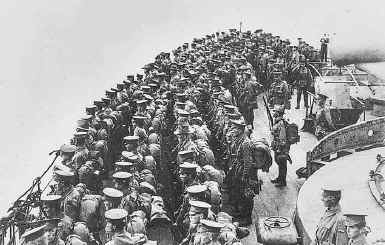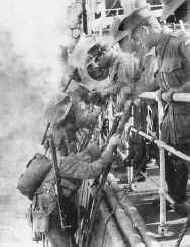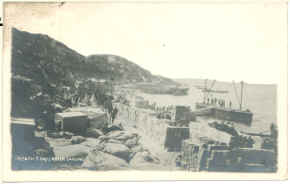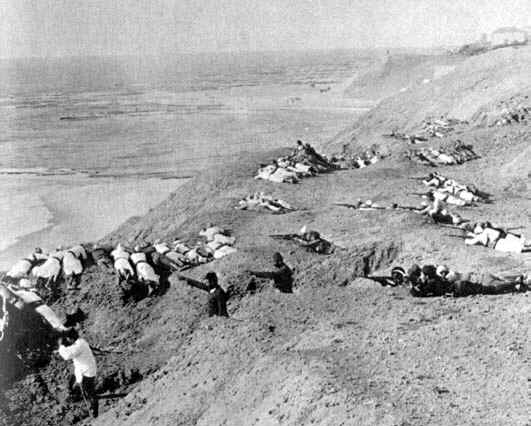 |
| Category:
Gallipoli |

|
|
|
|
|
|
The Landing at Anzac
An oil painting by George
Lambert. |
 |
|
The
landing scheme was a simple one, in outline at least. The 3rd Brigade's
4000 men would land as a covering force to secure a beachhead for two
Australasian divisions made up of six brigades. Those 4000 would go in
two waves. The first, consisting of 1500 men, were to start from three
battleships–Queen, Prince of Wales and London– then be
distributed between twelve tows, each made up of a steamboat, a cutter
(30 men), a lifeboat (28 men) and either a launch (98 men) or a pinnace
(60 men).
 |
 |
| The
filling, which took about forty minutes, was supervised by
adolescent midshipmen dressed in khaki-stained white duck and
carrying revolvers almost as big as themselves. They checked the
numbers and quietly called out, "Full up, sir!" at the
right time. Naval officers then gave the order to "Cast off
and drift astern" where the tows gathered, two on each side
of a battleship |
The
remaining 2500, the second wave, were to land from seven destroyers
shortly afterwards. Those destroyers would wait near the island of
Imbros and join the battleships, one and a half miles (about 2 km) from
the mainland, at 4.15 a.m. The first wave was scheduled to land a few
minutes earlier, and the destroyers would then sail in, full speed
ahead, adding a number of lifeboats borrowed from transport vessels to
the tows that had been used by the first wave. Once the whole 3rd
Brigade was ashore, the rest of the 1st Division would arrive on
transports, grouped in fours and coming in at regular intervals.

Such, at least, was the plan, and its first stage was negotiated without
difficulty. Troops on the battleships were woken at 1 a.m., given a hot
meal and a drink while the tows were being got ready, and by 1.30 a.m.
were ready for mustering into companies. This operation was carried out
with impressive efficiency: no one spoke; orders were given in whispers.
The only sounds were shuffling boots and muttered curses as men slipped
on the ladders leading down to the boats. But for many, the tension of
that still night magnified the sounds.
An
excerpt from Denis Winter's book,
25 April 1915 - The Inevitable Tragedy, University of Queensland
Press 1994
|

|

|
| The
beach, 2 hours after the Landing
|
The
same beach 3 days after the Landing
|
Prior to the start of the
Gallipoli campaign Anzac Cove did not exist. On 25 April 1915, as part
of the overall Allied plan, the Australian and New Zealand Army Corps
(or Anzacs) were ordered to land on the Peninsula's Aegean coastline to
seize the hill of Mal Tepe 5 miles inland and threaten the northern
flank of the Kilid Bahr Plateau. The exact position of the landing
remained vague with the military orders placing it between Gaba Tepe and
Fisherman's Hut, a distance of roughly two and a half miles. The naval
orders were somewhat more precise, pinning the southern flank of the
landing one mile north of Gaba Tepe. Once the covering force of the 3rd
Australian Brigade had landed and secured its position, the remainder of
the 1st Australian Division followed by the New Zealand and Australian
Division were then to push through towards Mal Tepe.
|

|
This
photo shows the advantage the Turks had. They held the heights.
They had the ability to fire down onto the Anzacs at all times.
Photo by a German photographer.
|
In the event the landing was very
confused and set in train a sequence of events that were never to be
overcome. Not only did the boats
of the first wave contract into a much reduced line significantly to the
north of the expected beach, they also became intermingled before the
troops could disembark. As a result the men went ashore in considerable
disarray. The second wave then followed in order, ironically compounding
the original errors. Throughout the day the main body of the 1st
Australian Division continued to land and move into this uncertain
position. But, as Turkish pressure mounted, any residual coherence
within the Anzac line was lost. Overnight, with the positions fragmented
and many wounded on the beach, the question of re-embarkation was
raised. But, after being rejected, the Anzacs were ordered to dig in
which they did with consummate success.
|

|
|
The Landing at
Anzac, April 25, 1915. Charles Dixon (NZ). |
In the confusion of the initial landing, most of the first boats
grounded along a narrow stretch of the shore between the small headlands
of Ari Burnu and what became known as Hell Spit. Offering a slight
degree of protection from Turkish observation and gunfire, this tiny
inlet became the heart of the Australian and New Zealand line and was
given the legendary name of Anzac Cove. Around it a claustrophobic,
overlooked position grew up. The Anzacs were unable to break out, as
their last concerted assault on 1-2 May clearly showed. But likewise the
successive attempts made by the Turks to drive them into the sea, which
culminated in the heavy attack of 19 May, were also all heavily
defeated. From the start of June until the evacuation on 19 December,
all actions were either diversionary or local, aimed simply at improving
positions in the line. Even the giant move to the north begun on 6
August against Chunuk Bair and the height of the Sari Bair ridge in the
end resulted in little improvement to the original Anzac position.
Life at Anzac was unique. The terrain was bewildering, formed both by
natural gullies and deep, man-made tunnels and trenches. The Turks were
at places almost within arm's reach, and access was possible only from
the sea via a handful of vulnerable piers which were all subject to
shellfire. The experience was fuelled by a heady mixture of futility,
pride, self-reliance and degradation. Unpleasant, unsought, it bestowed
on all those who survived it a badge of stamina and courage and helped
to define the distinctive national characteristics of the new nations of
Australia and New Zealand.
Nigel
Steel (IWM) http://www.iwm.org.uk/online/gallipoli/anzacopen.htm
|
|
Why were
the Anzac's landed at the wrong beach? |
 from Gallipoli by Les Carlyon ISBN
9-780732-911287: McMillan Press
from Gallipoli by Les Carlyon ISBN
9-780732-911287: McMillan Press |
Even 85 years on, after all the reports have been held up to the light and rows of dots Joined up, no-one Is quite sure how the Australians landed on the
wrong beach. Commander Charles Dix, who was in charge of landing the covering force, knew for
sure that all had gone wrong ,when the boats were within 50 yards of
the shore. 'Tell the Colonel' he shouted, 'that the damn fools have taken us a mile too far north!'
He had sensed the boats were off course before that. He was the
northern most tow and he thought the boats were crowding each other
towards the north. He steered across the stern of the boats inside him, shouting at them to keep to the south. This may be the reason the tows ended up in a bunch rather than spread
out over a wide front as they should have been.
The first explanation for the error was a 'northerly current'. Later came the suggestion that the navy crews on the tows
had mistaken Ari Burnu for Gaba Tepe. Others wondered whether the three battleships had anchored too far north, so that tows
heading due east from them were bound to strike Anzac Cove rather than Brighton Beach. There has also been speculation about a
late change of plans to move the Anzac landing up the coast.
We can probably forget about the current. The currents inside the Dardanelles are fierce; in the Aegean off Anzac Cove
they hardly matter. There was, moreover, no wind on the morning of the landing. A northerly current would at worst have pushed
the tows a few hundred yards north.
Ari Burnu looks nothing like Gaba Tepe. On a moonless night however, one dark blob on the shore looks pretty much
like another, so this allows the possibility of sailors mistaking one headland for another. Against that, the eye-catching
feature around Ari Burnu, even in the treacherous light before sunrise
is not the headland itself but the Sphinx. There is nothing like the Sphinx at Gaba Tepe. It could be that by the time the navy crews picked up the outline of the Sphinx they were so close to the shore that it was too late to veer to starboard.
There exists the likelihood that the three battleships - Queen, London and Prince of Wales - had anchored too far north, so that tows heading east from them were bound to land where they did. But why did the tows all end up so close to Ari Burnu? Assuming that the battleships were out of position, and that any northerly current would affect all tows
equally the boats should have landed on a wide front from the centre of Anzac Cove to Fisherman's Hut.
Where were the boats supposed to land Braithwaite's written instruction to Birdwood dated April 13 refers to a landing 'on the beach between Gaba Tepe and Fisherman's Hut'. This is as precise as he gets. The distance between these two points is better than two-and-a-half miles, a 'broad front' indeed. Birdwood's order for the landing, dated April 17, simply says the corps is 'to land north of Gaba Tepe, and occupy the heights covering the beach'. This order also mentions the landing of artillery horses, which were to be harnessed before disembarkation, and there is perhaps a tiny clue here.
Only a lunatic, and Birdwood was not that, would think of landing horses, harnessed or otherwise, on Anzac Cove or North Beach. Horses would, however, have been useful on the gentler country between Gaba Tepe and Bolton's Ridge.
General Bridges' order to the 1st Division for the landing, dated April 18, says:
"The division will land between Gaba Tepe and Fisherman's
Hut." This order also talks about the beach being divided into eight landing places. The arc of Anzac Cove is only about 600 paces, hardly long enough for eight separate landing places.
In a report to Braithwaite, dated May 8 Birdwood leaves no doubt about where he intended to land.
"I had originally intended landing with my right about one mile north of
Kaba [Gaba] Tepe, as the advances from there up to the ridges of the Sari
Bari [Bair] Hill, which I hoped to take, were fairly easy, while the country
further to the north was so difficult and precipitous that I feared troops would quite lose themselves in the dark, though the position there would probably be least guarded owing to the natural difficulties ... As a
matter of fact, the tows did not proceed quite due east on leaving the battleships but inclined to the north, and landed me about a mile and
half north of where I intended our first disembarkation should take
place".
Birdwood then made a virtue of the error.
"As subsequent events turned out, I cannot help thinking that the hand
of Providence directly guided us, for it so happened that the beach on which
we landed, and which we have since held, is one of the few places
where the steepness of the cliffs has made us to a great extent immune from
shell fire. Almost everywhere else we should probably have had to vacate owing to the heavy shell fire which
would most certainly have been poured on us".
|
|